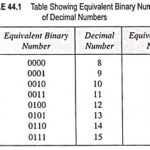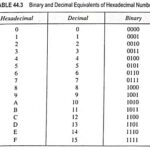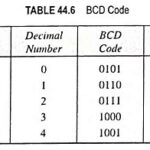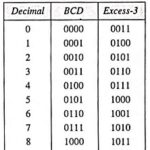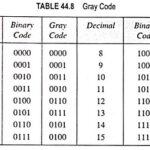Number System and Codes Articles:
Decimal Number System (Definition, Conversions & Examples): The decimal number system, as already mentioned, has a base of 10 and is a position-value system. The statement ‘the decimal number system has a base of 10’ implies that it contains ten unique … (Read More)
Binary Number System (Definition, Conversions & Examples): The binary number system is simply another way to count. It is less complicated than the decimal number system because it is composed of only two digits 0 and 1. Just as the decimal … (Read More)
Signed Binary Numbers (Definition, Conversions & Examples): In the decimal number system, a plus (+) sign is used for denoting a positive number and a minus (-) sign for denoting a negative number. The plus sign is normally dropped, and absence … (Read More)
What is Double Precision System? For any computer, the word length is fixed. Most present day computers are 16 bit and in a 16 bit computer, that is, in a computer with 16-bit word length, only numbers from +216-1 – 1 (i.e., … (Read More)
What is a Floating Point Number? The real numbers considered so far were represented in what is known as fixed point notation. In such notation, the position of the decimal is fixed for a fixed number of bits. For example, a … (Read More)
Octal Number System (Definition, Conversions & Examples): The number system with base (or radix) eight is known as the octal number system. Although we can use any eight digits, it is customary to use the first eight decimal digits: 0, 1, … (Read More)
Hexadecimal Number System (Definition, Conversions & Examples): The binary number system forms the natural choice for the two-state systems. But in this system, the numbers tend to get short rather long. Hence to reduce the length of a given number it … (Read More)
What is Binary Coded Decimal (BCD) Code? The 8-4-2-1 code or simply the Binary Coded Decimal code is composed of four bits representing the decimal digits 0 through 9, 8, 4, 2 and 1 are the weights of the four bits … (Read More)
What is Excess-3 Code? (Definition and Examples): The excess-3 code, abbreviated as XS-3, is an important 4-bit code sometimes used with binary-coded decimal (BCD) numbers. It possesses advantages in certain arithmetic operations. The excess-3 code for a decimal number can be obtained … (Read More)
What is Gray code? (Definition, Conversions & Examples): This Gray code belongs to a class of codes called minimum-change code, in which only one bit in the code group changes when going from one step to the next. This is an … (Read More)
What is Alphanumeric Codes? – ASCII code, EBCDIC Code: In order to communicate, we need not only numbers but also letters of alphabet, punctuation marks and other special characters. These codes are called alphanumeric codes. Most of these codes, however, also … (Read More)
